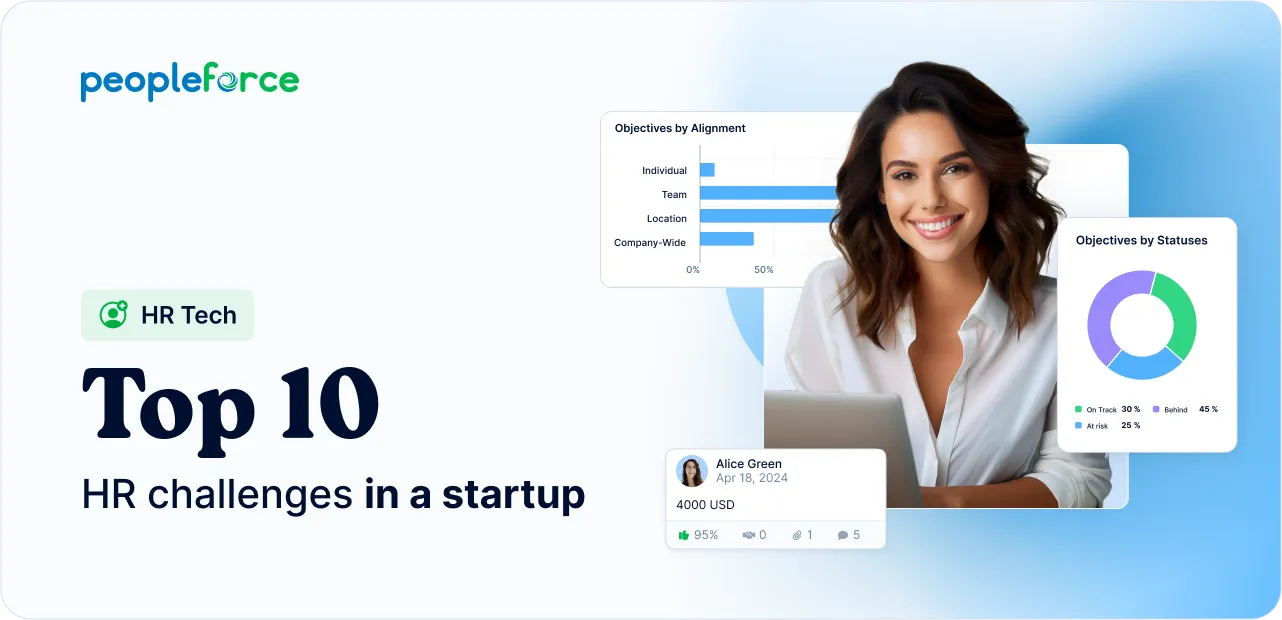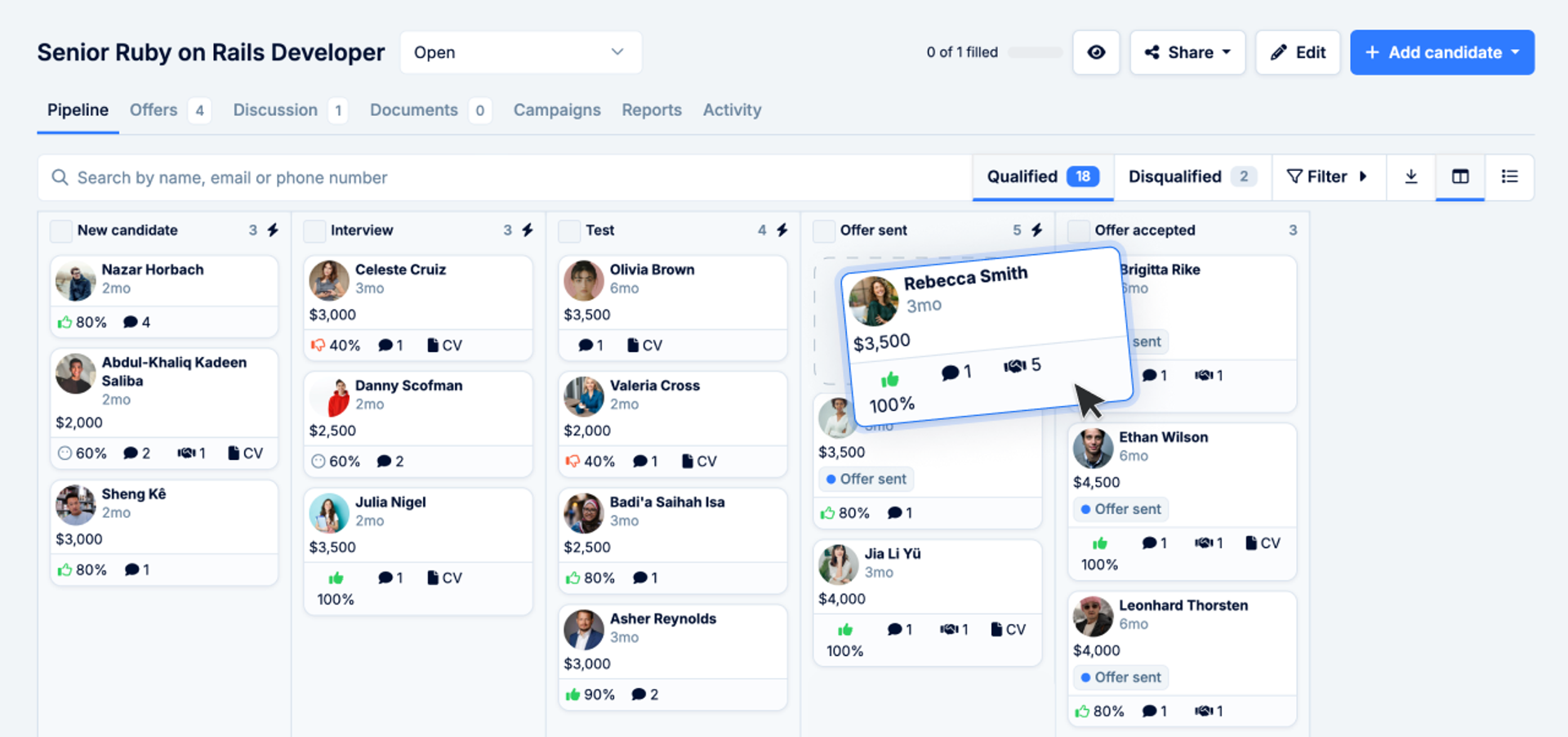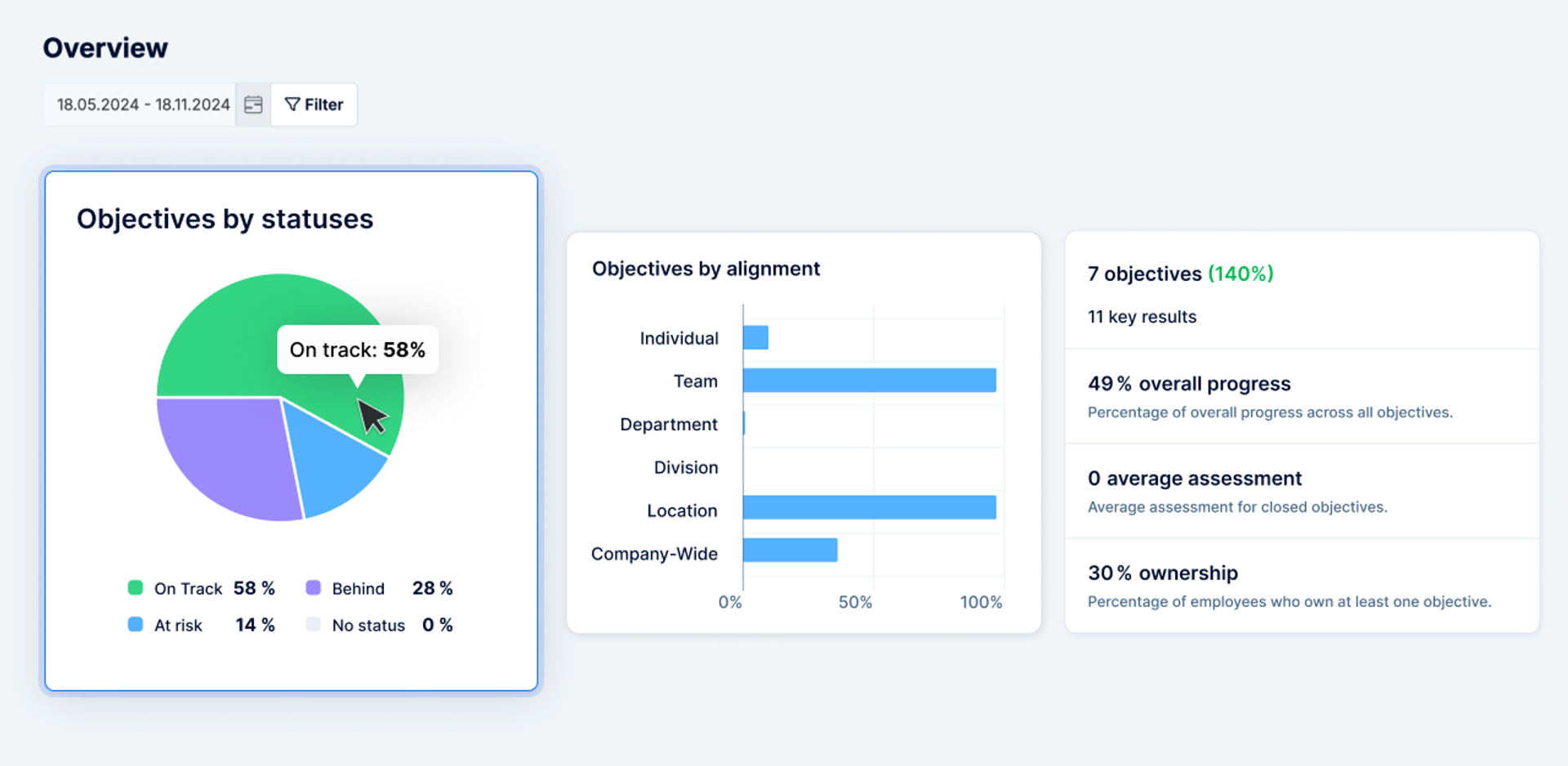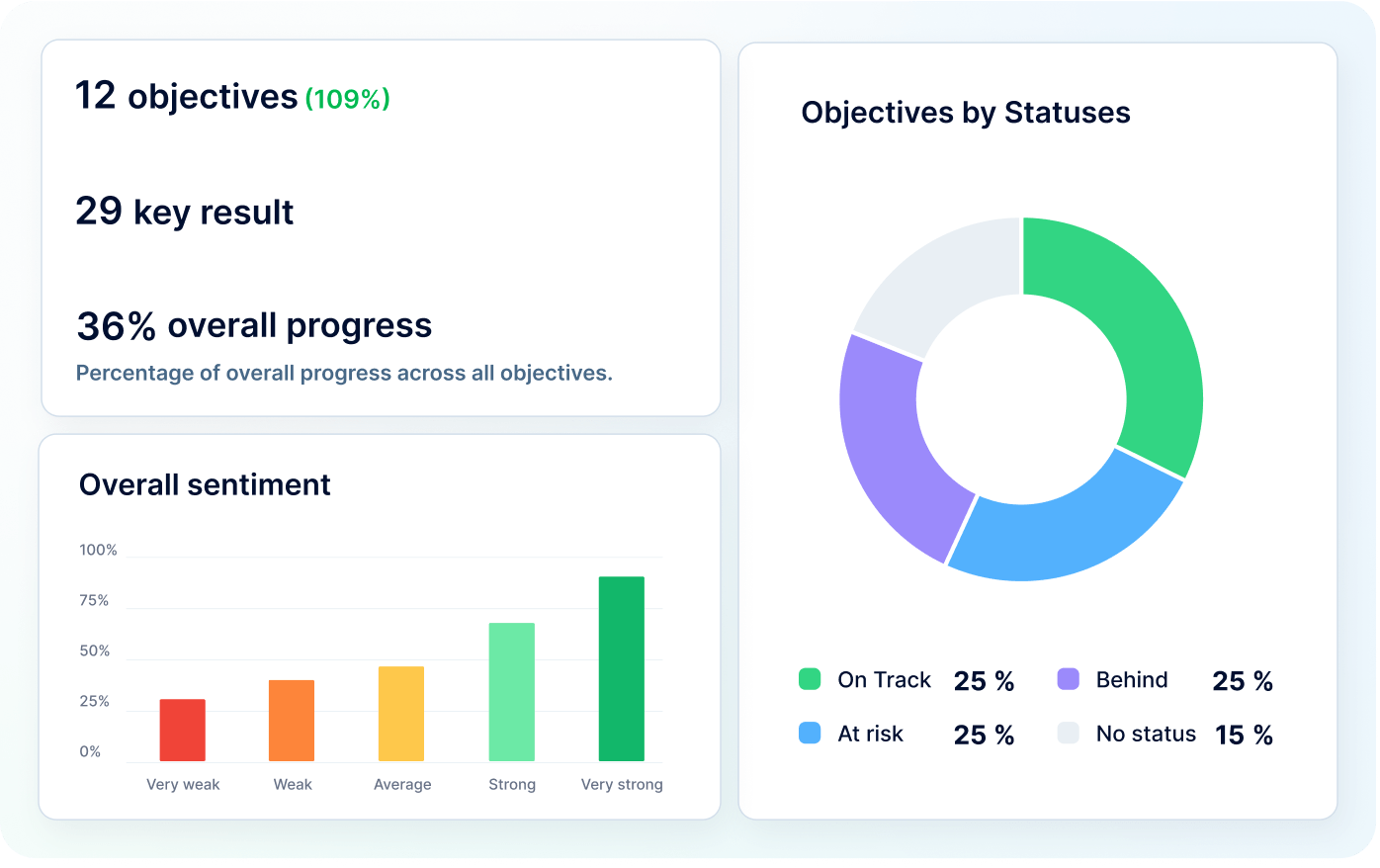
10 essential HR solutions for common startup challenges
Startups have a lot on their plates. They must focus on developing products and services, securing funding, and expanding their business while staying competitive.
To top it off, HR challenges occur as they scale and grow. From attracting and retaining new employees to improving employee engagement and relations, startup company challenges come in many forms. Luckily, you can address and solve most of them with a dedicated all-in-one HR platform.
In this article, we’ll explore the most significant challenges facing HR and provide tips on overcoming them.
10 HR challenges faced by startups
Acquisition of suitable talent
There’s one quote credited to Steve Jobs – “When you're in a startup, the first 10 people will determine whether the company succeeds or not.” Surrounding yourself with the right talent is crucial for your organizational performance.
But there’s one issue – 36% of HR leaders claim their sourcing strategies are insufficient, making it difficult to find the skills their companies need. HR professionals can overcome this by developing a robust recruitment process and strategy:
- Invest in employer branding – Launch a survey to discover what your current employees like about your startup. The talent acquisition team or HR managers can use those unique aspects to promote your business on LinkedIn and other relevant platforms.
- Implement the employee referral program – HR teams can implement the program and offer incentives to employees for successful referrals. This is one of the best ways to find people who fit your company culture.
- Leverage social media – Most job seekers look at their potential employer’s LinkedIn and other media accounts. You can draw their attention with posts that highlight your startup’s benefits and culture.
- Use an Applicant Tracking System (ATS) – Finding talent is easier with the ATS developed by PeopleForce. The system allows you to store all candidate data in one place, access insights on how your Talent Acquisition team operates, and streamline the candidate selection process with automated emails and templates. The platform integrates with over 3,000 job search websites, including international ones, and allows you to post your vacancies directly from the system, which will significantly simplify the hiring process and reduce the number of errors.
Human resources challenges are easier to overcome with the right strategy, people, and tools. Make sure your startup has them to thrive in the tight labor market.

Creation of the proper retention programs
Attracting top talent is one thing, but retaining them is another challenge. High employee turnover rates can be rather costly for startups. HR leaders know for a fact that it costs more to replace employees than to retain them.
Those costs aren’t financial only. Turnover also affects productivity and employee morale. If HR teams take weeks or months to find a suitable candidate, the remaining team members probably need to put in extra work to cover them.
Overcoming HR challenges like this one is possible with a retention strategy. To retain talent, you should:
- Offer competitive pay and benefits packages – According to Gallup, 16% of employees who left their companies identified “Pay/Benefits” as their main reason in 2023. Although this figure is lower compared to 2022 (when it was 20%), it still shows that employees prioritize competitive pay and a benefits package. For instance, you can offer flexible work arrangements, private health insurance and birthday bonuses.
- Provide training and development opportunities – Employees want to learn new skills and grow in their careers. That’s why you should invest in training and development programs. You can offer paid courses or allow employees to work on new projects.
- Build a positive company culture – As you know, corporate culture has a huge impact on employee retention. Make sure your entire workforce feels valued and respected. HR professionals can encourage regular feedback and recognition from managers and peers.
These strategies can help you have a high employee retention rate. Don’t focus on leaving a good impression in the beginning only – retain talent by actively investing in people that make your startup thrive.
Keeping the team's motivation and engagement high
HR for startup companies has an important task: ensuring employees remain engaged and motivated. A Gallup report found that only 23% of the workplace is engaged. A less engaging work environment leads to lower productivity and profitability.
You can improve the employee experience (and, thus, engagement) by following a few guidelines:
- Communicate frequently – Frequent and timely communication improves employee engagement. You can share updates on business success and events or celebrate anniversaries within teams. That communication brings both office and remote workers closer to your company.
- Share your mission and vision – Drafting a clear mission and vision ensures employees understand business goals and how they can help you achieve them. Your team members will be more motivated when they know what they are working toward.
- Encourage feedback – HR teams should collect employee feedback. You can launch a space where employees can leave their ideas and opinions.
You can monitor engagement with PeopleForce, an employee engagement survey solution. The tool lets you:
- Measure engagement
- Gauge satisfaction and motivation
- Analyze data-driven insights
- Customize the platform to meet your needs

Maintaining healthy employee relations
HR in startups often face the challenge of not only attracting top talent but also keeping them by creating a positive work environment. One of the key tasks is to build healthy and productive employee relations, ensuring that everyone feels valued and connected. Without strong employee relations, teams can become disengaged, leading to lower morale and higher turnover rates.
How to address the challenge?
HR departments should focus on three main pillars: diversity, inclusion, and teamwork. By prioritizing these areas, HR can create a supportive environment where employees feel respected and part of the team, regardless of their background or location.
- Diversity and inclusion: Inclusive practices ensure that everyone feels they belong and can contribute. HR can organize events like cultural awareness days or diversity training sessions to help employees understand and appreciate each other's differences.
- Teamwork and collaboration: Encouraging teamwork through cross-functional projects helps employees bond and learn from each other. A great way to do this is by hosting knowledge-sharing sessions where employees showcase their expertise. For instance, a Software Engineer could teach a session on a programming language, while a Designer could offer tips on using Figma.
- Mentorship and buddy programs: Setting up mentorship programs and buddy systems is another way to strengthen employee relationships. Mentorship gives employees access to guidance and support, helping them grow professionally. A buddy program can pair new hires with experienced team members, making onboarding smoother and helping them settle in faster.
- Remote work and communication: For companies with remote employees, it’s important to ensure that everyone stays informed and feels connected to the team. Regular virtual check-ins, all-hands meetings, and collaborative platforms can help remote workers remain engaged. Clear and consistent communication is key, and HRIS systems (Human Resources Information Systems) can play a crucial role here. These systems can centralize information, streamline communication, and help employees stay up-to-date with important company news and events.
Employees’ performance and effectiveness monitoring
Performance management makes sure everyone is doing their fair share of work and supporting company goals.
It’s particularly essential for startups for numerous reasons:
- Employee performance has the power to transform a startup. Each individual input drives you toward success. By focusing on performance management, HR teams can identify skill gaps, offer training and support an employee’s career development.
- Career advancement plans and rewards for good performance can improve employee motivation and engagement.
- It can make your startup more attractive to job candidates by showing them you actually care about your employees' career advancement and are ready to invest time and resources into it.
How to address the challenge?
- Hold regular 1:1 meetings: These meetings provide an opportunity for managers to give feedback, discuss career development, and address any concerns that might affect performance.
- Set clear goals and expectations: Ensure that each employee knows what is expected of them and how their work contributes to the company’s objectives. This clarity drives accountability and motivation.
- Use 360-degree feedback (performance reviews): Implement comprehensive feedback systems like 360-degree reviews to give employees a well-rounded understanding of their strengths and areas for improvement.
Change management and rapid growth navigation
Change management is one of the most daunting challenges for HR. People react differently to changes. Some adjust to them, while others seek ways to ignore them. HR managers and teams are at the center of the issue – communicating and leading employees through every change.
Every startup needs a change management process to plan, implement and monitor changes. This ensures the changes are introduced smoothly and efficiently, without affecting employee health, performance and satisfaction.
There’s no one-size-fits-all approach, but top management and HR leaders can:
- Recognize the need for change
- Evaluate its impact
- Develop a plan for introducing the change
- Implement the plan
- Monitor and adjust your approach as needed
Startups have a fast-paced environment, so they must adopt an agile spirit. Your business should rapidly implement changes to meet customer needs and beat the competition.
Succession planning and leadership securing
Succession planning identifies and rewards top talent within your business. It ensures you have a pool of skilled individuals ready to take on different roles in case of a departure or retirement.
Basically, this means that you’re getting ready for the future, where you’ll be able to navigate any changes made to your current organizational structure. Let’s see how you can do this:
- Identify key positions – Top management and HR leaders should identify the critical positions for succession planning. The first that will come to mind are executive and leadership positions. However, you can include any position critical for your startup’s operations. For instance, you may choose customer-facing positions.
- Write down the necessary competencies and skills – You won’t always find the perfect candidate, but it’s essential that you know what you’re looking for. Identify skills and competencies for each role. Perhaps existing employees would match the profile, making your search easier.
- Conduct research – HR managers should encourage their teams to check what the candidate market has to offer. They might find relevant job seekers and learn their salary expectations.
Ideally, the top and HR management should create succession plans years in advance. This prepares them for any changes within the organizational structure.
Creation of a good first impression
Covering processes, HR policies and labor laws is important for every employee. However, sharing too much information while new employees are adjusting may ruin their onboarding experience. A strong onboarding process significantly impacts employee retention and productivity, but delivering essential information without overwhelming new hires is a common challenge.
How to overcome this
1. Personalize onboarding
Adapt the onboarding experience for each role and department to ensure new hires get relevant training and resources.
2. Start with pre-boarding
Engage new employees before day one. Share insights about the company culture, team dynamics, and their first-week agenda.
3. Leverage onboarding software
Tools like PeopleForce simplify onboarding by automating tasks like sending welcome emails, scheduling meetings, and tracking progress.
Pro Tip: Regularly collect feedback from new hires to refine and enhance your onboarding process for better engagement and results.
You must find a perfect balance between passing information to new employees and ensuring they aren’t overwhelmed.
However, you must also remember that pre-boarding shapes your employee experience. Pre-boarding starts when a candidate accepts your offer and lasts until their start date. You have an opportunity to involve your future employees in the organizational culture and team long before they begin working.
HR for startups must develop a proper pre-boarding and onboarding process. Employee onboarding software makes this possible.
With PeopleForce, you can tailor onboarding programs to each department's needs. The tool allows you to create automated onboarding flows triggered by specific actions. Once you add a new hire, they can receive a welcome letter and all the way through the 1-on-1 meeting invitation.
PeopleForce also helps with pre-boarding. You can share responsibilities and expectations with newcomers, and they can learn more about their team and other members. Share anything you like with them through PeopleForce!
Improving employees’ skills
Learning and development initiatives encourage employee skill-building and show that your startup is willing to invest in its most valuable resource: people. However, HR challenges occur when HR leaders try to bring these initiatives to life. After all, they require resources and funding.
Before you develop these programs, you should:
- Assess the current employee skills – Identify which skills employees possess and lack. You should also brainstorm which skills your startup will need in the future. This analysis will help you determine any potential gaps.
- Determine the budget – HR managers know how much the startup can set aside for each learning and development initiative. Allocate the budget to support any future goals.
- Plan different programs – Mix training programs to accommodate various needs and meet expectations.
- Ask employees to participate – Employees can suggest topics for your learning and development programs. They can also speak at one of the events and share their expertise.
Some of the cost-effective solutions that improve employee experience are:
- Educational courses – Each employee receives a certain budget that allows them to take online classes or workshops and helps them build skills.
- Mentoring – Develop a mentorship program where employees can acquire leadership and other skills. They can attend individual or group meetings.
Working on the compensation and benefits
Now, we’ve come to the topic all employees like – compensation and benefits. Show that you care about your employees’ well-being, and you won’t have any issues with attracting and retaining people.
What can you do? Apart from fair compensation, you can come up with a list of benefits most employees want, such as:
- Wellness programs
- Flexible work arrangements
- Employee health insurance
- Bonus structure
- Paid and unpaid leave
Different solutions make it easier to manage your benefits packages. For instance, PeopleForce comes with leave and paid time off tracking.
Forget about spreadsheets – PeopleForce unites all data into one platform. Your employees can plan and request time off in just a few clicks. At the same time, your HR team can:
- Gain clear visibility of all absences
- Customize different leave types and policies
- Set paid and non-paid balances
- Automate accounting
So, use a system like PeopleForce to save time and improve the performance of your HR team members.
Summary
HR for startup companies faces different challenges, from recruitment and retention to onboarding and change management.
The best way to address this is with all-in-one HR software like PeopleForce. It helps you automate HR tasks, build an effective onboarding process, measure employee satisfaction and access useful analytics.
Ready to have PeopleForce on your side? Try now!
Get started with PeopleForce today
Automate your HR routine to create a high performance culture in your company. PeopleForce is your best HRM alternative to stay business driven but people focused.

Recent articles
Why and how to conduct an HR audit as an SMB
As a small or mid-sized business (SMB), conducting an HR audit is essential for ensuring that your HR practices are efficient, compliant, and aligned with your business goals.
How much time HR platform saves for HRs and admins
Discover how modern, all-in-one HR software simplifies complex processes, ensures compliance, and boosts efficiency to help HR teams manage growing responsibilities with ease.
How to create a perfect retention strategy with the HR platform
Employee retention has become a major headache for businesses. Many companies, even the most successful, can be dealing with unhappy employees behind the scenes.

